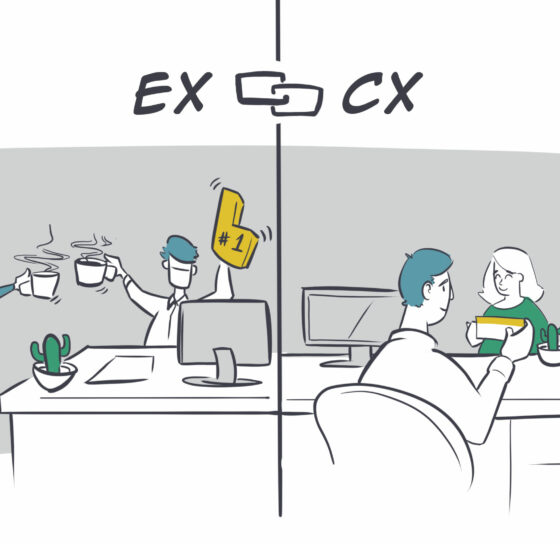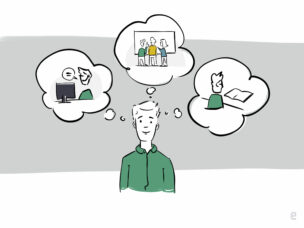why employee experience is so important
There are many reasons why you should pay attention to the employee experience. Think of:
- Engaged employees are more productive.
- Satisfied employees form a positive corporate culture.
- The positive influence on the business results.
- Attracting and retaining suitable talent.
- Timely response to expectations of new generations.
- The positive impact on the customer experience.
- Proactive attitude of employees leads to more innovation.
We could go on and on and you may have already concluded that they are all connected. Nevertheless, in this article we limit ourselves to two main objectives: attracting and retaining the right people AND the positive impact on the service and associated customer experience. These are the conditions for achieving sustainable growth, and are therefore essential for becoming and remaining a customer-oriented organisation. The employee experience (EX) should therefore certainly not be an HR project that you occasionally add to it. Continuous focus and attention is required in relation to your services.

EX from a service provider perspective
Optimizing the experience for the customer is done with the entire organization. With the customer journey you look organization-wide for improvements and opportunities to optimize the customer experience. Employees must recognize the value of a certain experience, so that they work together on the basis of that value. That is why you need employees with a customer-centric mindset. Employees must also be facilitated to provide customer-oriented service.
We call this employee engagement: the will to contribute to the organisation-wide vision of customer focus.
You can develop that mindset by acquiring new knowledge together with the employees and giving them tools to better empathize with the customer, so that they serve the customer as well as possible with their decisions and actions. We call this employee engagement: the will to contribute to the organisation-wide vision of customer focus.
Another example: a company has a very good complaints monitor: it records what customers often call about and are unsatisfied with. If this is not given priority to resolve, (other) customers will continue to contact you about this, this will result in lower employee engagement: “nothing will be done with my suggestion anyway”, the customer will remain unsatisfied and the costs will be high because several customers keep in touch with the same problem.
EX from an employer perspective
From an HR perspective, the employee experience consists of all the experiences employees have with their employer: from considering applying for a job to saying goodbye and perhaps even the alumni program. You are talking about the employee lifecycle. You can take care of it down to the last detail on paper, but what counts is how employees think about it and how they feel about it. The experiences and needs of the employees are central. This is practice what you preach at its best. After all, if you want to be a customer-centric organization at the front, you must also be that internally towards your employees.
Attracting and retaining the right people (and thus achieving high employee satisfaction) is done by working on three aspects: bricks, bytes and behaviour.
- Bricks: all physical aspects of the job. This goes beyond a coffee machine and a trendy office design. This also includes things like salary, working conditions, commuting, training opportunities and growth paths and culture.
- Bytes: the technologies that employees use, both directly to perform their work and indirectly to reserve meeting rooms, for example. Also consider the accessibility of systems when working independently of location, such as at home or at a customer’s.
- Behaviour: the organizational culture and the attitude of the employees. It is important that feelings are. heard and that there is a feeling of recognition. Managers obviously have an exemplary role in this: employees are given sufficient personal responsibility and the corresponding mandate to solve things. is there room for development and growth?
By working on bricks, bytes and behaviour, you create an environment in which employees thrive and achieve results as a result.
employee experience: where employers and service providers come together
From the service provider (CX) perspective you approach the employee experience with the aim of improving the customer experience. From the employee (HR) approach, the employee’s experience is in the spotlight. After all, it is not just about the individual employee lifecycle, it is also about getting the entire organization on board in changes. This also indirectly results in an improved customer experience: satisfied and engaged employees ultimately ensure satisfied customers.
If you want to improve the employee experience, it is really no different than working on the customer experience. The only difference is that the customer is now the employee. That can make a journey just that little bit more exciting. It is often easier to look objectively at a fairly anonymous customer than at a colleague you have been working with for a long time. Also, remember that you cannot view the workforce as a homogeneous group. Just like with customer journeys, you also create different customer need profiles for employee journeys in which you map out the difference in employee needs.
“Clients do not come first, employees come first. If you take care of your employees, they will take care of the clients.” – Richard Branson
synergy on employee experience
The two different perspectives on the employee experience reinforce each other. It is therefore good to pay attention to both. This gives you a holistic view of the employee experience and makes it easier to make connections and implement improvements. That’s synergy, and it only increases when you put it in the context of customer experience.
So don’t forget your own people if you want to take steps on customer experience. Be customer-centric by putting the employee experience first. To quote Richard Branson: “Clients don’t come first, employees come first. If you take care of your employees, they will take care of the clients.”
Interested in further discussing how we can help improve the employee experience and the link with the service? Contact us or go directly to the Optimizing Employee Experience training of our Academy.











